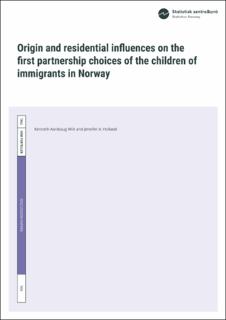Origin and residential influences on the first partnership choices of the children of immigrants in Norway
Working paper
Permanent lenke
https://hdl.handle.net/11250/2833147Utgivelsesdato
2021-11Metadata
Vis full innførselSamlinger
- Discussion Papers [1002]
Sammendrag
Using Norwegian register data on migrant-background individuals born 1985 to 2001 who were either native born or who immigrated as children or teens, in combination with data from the World Marriage Database, we investigate how residential partner markets and marriage behavior in countries of origin shape partner choice and choice of union type in Norway. Results from crossclassified multilevel hazards models confirmed that a higher share of “co-ethnics” in the county of residence was negatively related to exogamy and positively related to cohabiting endogamously. Further, a pattern of less traditional partnership behavior in countries of origin was associated with less traditional behavior in Norway. More specifically, a later singulate mean age of marriage (SMAM) in countries of origin was positively related to cohabitation, whereas those originating from a country with a higher share of unmarried in ages 25 to 29 were less prone to marry endogamously. These associations varied by ages at arrival and gender. Taken together, our results provide evidence that norms and behaviors in countries of origin continue to shape the partnership behaviors of young migrant-background individuals, even among those who were born and raised in Norway.

